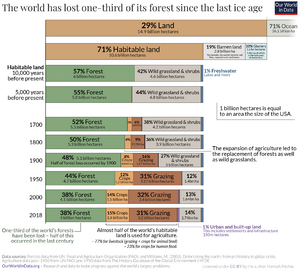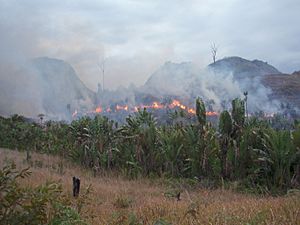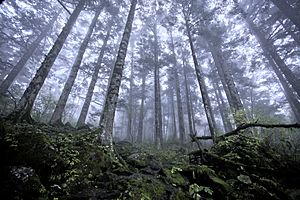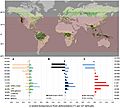Deforestation facts for kids
Deforestation is when forests are destroyed by cutting down trees and not planting new ones. The main reasons for this are to clear land for farms, ranches, and cities. Trees are also cut down for firewood and lumber (wood used for building).
When forests are cut down, many animals lose their habitat (their home). This can lead to their death or even extinction. The problem is even worse in primary forests, which are forests that humans have never touched before. Deforestation also releases stored carbon into the air.
Planting new trees in places where forests have been destroyed is called reforesting.
Contents
Why are Forests Important?
Forests are often planted to protect us from natural disasters like floods. They also help the water cycle work correctly. When forests are lost, the soil they protected often washes away. This loss of soil is called erosion.
Trees are also very important for carbon sequestration, which means they store carbon. They help keep the right balance of oxygen (O2) and carbon dioxide (CO2) on Earth. Trees take in the carbon dioxide that we breathe out and release the oxygen that we breathe in.
Forests do many important things:
- They help control the water cycle.
- They help create healthy soil.
- They stop soil erosion.
- They provide habitats for many animals.
- They give us most of our oxygen.
- They keep oxygen and carbon dioxide levels balanced in the air.
- They help balance the atmosphere.
- They help control the temperature.
A Look at History
Deforestation around the world greatly increased starting around 1852. In 1947, our planet had about 15 to 16 million square kilometers of mature tropical forests. But by 2015, about half of these had been destroyed. The total land covered by tropical rainforests went down from 14% to just 6%. A lot of this loss happened between 1960 and 1990. Scientists think that if this continues, these forests could disappear by the middle of this century.
What Causes Deforestation?
Land can be used for many things besides growing trees. The biggest reasons land that was once forest is now used for something else are farming and ranching. Some forest land is also cleared for roads and buildings, especially in urban areas where many people live. As the world's population grows, people need to remove more trees. They also use the wood from trees as lumber to build things or burn it as firewood.
How Deforestation Affects Our Environment
Impact on the Air
- Further information: Deforestation and climate change
Deforestation is happening all the time and is changing our climate and geography.
When trees burn or rot, the carbon they stored can go back into the air as carbon dioxide. Scientists believe that because carbon dioxide is a greenhouse gas, deforestation can cause global warming. They have estimated that cutting down tropical forests causes about 20% of the world's greenhouse gas emissions.
Impact on Water
The water cycle is also affected by deforestation. Trees play a very important role in how the water cycle works:
- Their leaves and branches (called canopies) catch rain. This rain then evaporates back into the air. Without tree canopies, the air would be drier, and less rain would fall.
- The leaves and plant material on the ground around trees, along with their stems and trunks, slow down water flowing over the surface. Without these, flash floods would be more likely.
- Tree roots create large, pipe-like trails in the soil. These trails help water soak into the ground. Without them, water would not flow through the soil as easily.
- Trees absorb groundwater from the soil and release moisture into the air through their leaves (this is called transpiration). Without transpiration, the air would be drier, and trees would not get the moisture they need because there would be less rain.
Tropical rainforests produce about 30% of our planet's fresh water.
Deforestation changes normal weather patterns, making the weather hotter and drier. This can lead to more droughts, crop failures, melting ice caps, and coastal flooding.
Impact on Soil
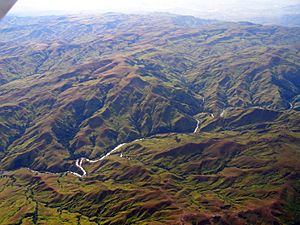
In a healthy forest, the soil is protected by a layer of leaf litter (fallen leaves) and humus (rotting plant material). These layers cover the forest floor and absorb the impact of raindrops. They are porous (have tiny holes) and let rainwater slowly soak into the soil instead of flowing over the surface. The roots of trees and plants hold soil particles together, stopping them from being washed away. The leaves and branches also slow down raindrops before they hit the ground, reducing their force. However, it's mostly the forest floor, with its layers of leaf litter and organic matter, that stops soil erosion.
Deforestation increases soil erosion. This happens because the protective layers of humus and leaf litter are removed, the plants that hold the soil together are gone, and heavy logging equipment can compact the soil. If heavy rains follow severe fires, a lot more erosion can happen.
One of the biggest causes of soil loss in 2006 was the slash and burn method used in tropical forests. In some parts of the world, large areas of land have become unusable. For example, in the central plateau of Madagascar, which is about 10% of the country's land, almost no plants grow. There are huge gullies (deep channels from erosion) that are often more than 50 meters deep and 1 kilometer wide. Shifting cultivation, a farming system that sometimes uses slash and burn, makes the soil less and less fertile.
Impact on Living Things (Biodiversity)
Forests support biodiversity, meaning they are home to many different kinds of plants and animals. Forests also provide medicinal plants. Tropical rainforests have the most diverse ecosystems on Earth. About 80% of the world's known biodiversity can be found in them. When humans remove or destroy large areas of forest, the soil gets worse, and there are fewer different kinds of living things. Some plant and animal species can even become extinct. Some scientists believe that over 40% of the animal and plant species in Southeast Asia could disappear in the 21st century.
How Deforestation Affects Health
Public Health
Some scientists think that deforestation can expose people to zoonotic diseases. These are diseases that can pass from animals to humans. Diseases linked to forests include malaria, Chagas disease, African sleeping sickness, leishmaniasis, Nipah virus, Avian flu, Swine Flu, Lyme disease, HIV, and Ebola.
General Information
According to the World Economic Forum, 31% of new diseases are linked to deforestation. The US Centers for Disease Control and Prevention (CDC) states that 75% of new human diseases came from animals.
In 2016, the United Nations Environment Programme (UNEP) published a report showing the causes of new diseases:
| Cause | Percentage of new diseases |
|---|---|
| Land-use change | 31% |
| Agricultural industry changes | 15% |
| International travel and commerce | 13% |
| Medical industry changes | 11% |
| War and Famine | 7% |
| Climate and Weather | 6% |
| Human population and behavior | 4% |
| Problems with public health systems | 3% |
| Bushmeat (wild animal meat) | 3% |
| Food industry changes | 2% |
| Other | 4% |
Here are some recent diseases and their environmental causes:
| Disease | Environmental cause |
|---|---|
| Rabies | Forest activities in South America |
| Bat-associated viruses | Deforestation and more farms |
| Lyme disease | Forests being broken into smaller pieces in North America |
| Nipah virus infection | Pig farming and more fruit farms in Malaysia |
| Japanese encephalitis virus | Rice farming with irrigation and pig farming in Southeast Asia |
| Ebola virus disease | Forest losses |
| Avian influenza | Intensive Poultry farming (raising many chickens) |
| SARS virus | Contact with civet cats in the wild or in live animal markets |
Economic Effects
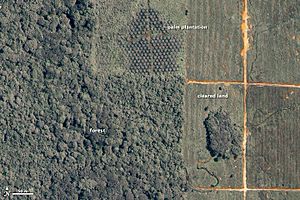
The World Economic Forum says that half of the world's GDP (the total value of goods and services produced) depends on nature. For every dollar spent on restoring nature, there is a profit of at least 9 dollars.
People in both rich and developing countries use wood for building, fuel, and paper. In developing countries, almost three billion people rely on wood for heating and cooking. The economy might seem to do well in the short term when trees are cut for products. However, usually, not enough new trees can be planted in time to replace them. This causes the economy to suffer in the long run.
Illegal logging (cutting trees without permission) causes billions of dollars in losses to countries each year. The European Union is one of the biggest buyers of products made from illegally deforested wood.
How We Can Control Deforestation
Many countries are working to control deforestation. They have started programs to help with the problem.
- Reducing Emissions: The United Nations and the World Bank have programs to reduce deforestation. Since trees absorb carbon dioxide, having more trees means less CO2 is released into the air. The "Reducing Emissions from Deforestation and Forest Degradation" (REDD) program offers money or other good reasons to developing countries if they find ways to build without cutting down forests.
- Government and Private Policies: Governments can make laws to protect forests, making it illegal to cut trees without special permission. Private companies can promise to use their land wisely and only buy products from companies that do not cause deforestation. The Paris Agreement is an example of such an effort.
- Land Rights: Another way to protect forests is to give the right to use the land from the government to the local people who have lived there for a long time.
- Farming Practices: New ways of farming are being developed to get more use out of one piece of land instead of needing many. For example, in cyclic agriculture, cows graze on farmland that is resting. The cows help the land by adding nutrients (from their waste) to the soil, preparing it for future crops.
- Monitoring Deforestation: Satellite images help scientists see where on Earth they need to focus their efforts to fight deforestation.
- Forest Management: Planning ahead by planting more trees than we think we'll need for the future is one way to manage forests well. Reforestation in areas where trees have been cut is another good way. In areas where "slash-and-burn" is used, switching to "slash-and-char" can make the soil rich and healthy for new trees.
- Sustainable Practices: Bamboo grows much faster than trees. Using bamboo instead of wood for building and making products can reduce the need to cut down trees.
- Forest Plantations: Some places have forest plantations. These are large areas where trees are planted in an organized way. They can produce more healthy trees per acre than a natural forest.
Interesting Facts About Deforestation
- More than half of the world’s tropical forests have been destroyed since the 1960s.
- In 2019, the world lost an area of primary rainforest the size of a soccer field every six seconds.
- Forests release carbon dioxide when they are cleared or burned. About 12% of global greenhouse gas emissions come from deforestation.
- It is thought that within 100 years, there might be no rainforests left.
- 20% of the world’s oxygen is produced in the Amazon forest.
- Almost half of the world’s timber and up to 70% of paper are used by Europe, the United States, and Japan alone.
- Worldwide, more than 1.6 billion people rely on forest products for some or all of their income.
Related pages
Images for kids
-
Deforestation in New Zealand.
-
Satellite image of deforestation in eastern Bolivia. Worldwide, 10% of wilderness areas were lost between 1990 and 2015.
-
Deforestation of the Amazon rainforest in Brazil's Maranhão state, 2016.
-
The last batch of sawn wood from the peat forest in Indragiri Hulu, Sumatra, Indonesia. This deforestation was for an oil palm plantation.
-
Fires on Borneo and Sumatra, 2006. People use slash-and-burn deforestation to clear land for agriculture.
-
Deforestation of Brazil's Atlantic Forest around 1820–1825.
-
Deforestation in Suriname around 1880–1900.
-
Deforestation in Venezuela for cattle breeding.
-
Satellite imagery of locations of the 2019 Amazon rainforest wildfires from August 15 to August 22, 2019.
-
Deforestation in Ecuador.
-
Deforestation in Germany.
See also
 In Spanish: Deforestación para niños
In Spanish: Deforestación para niños



